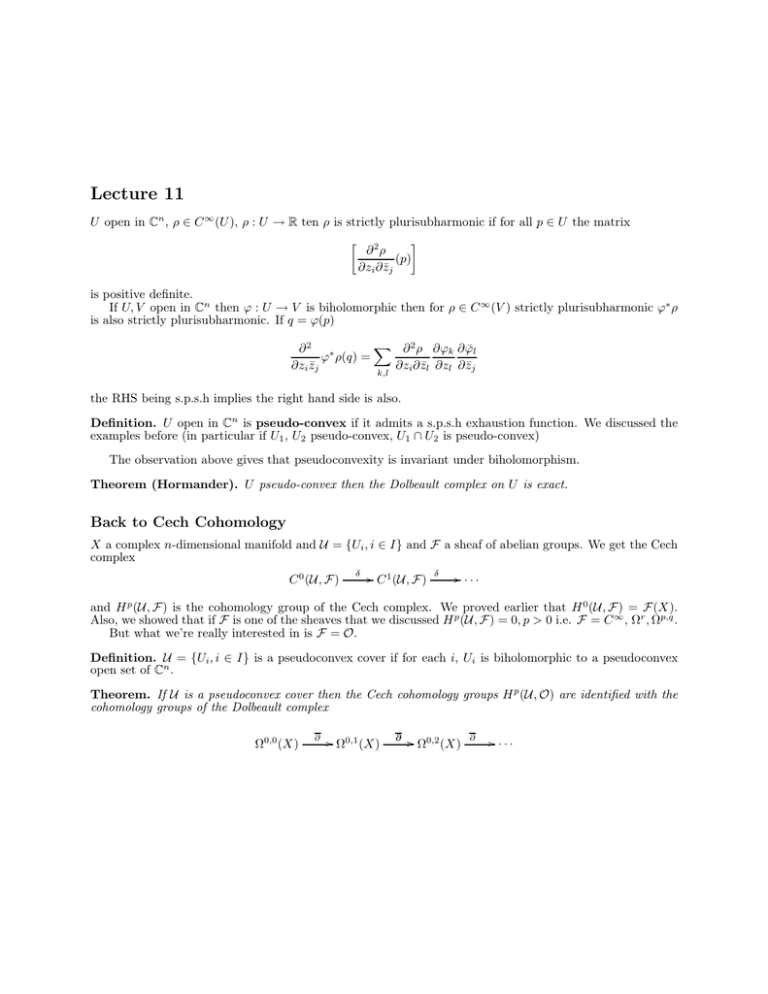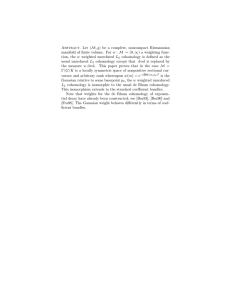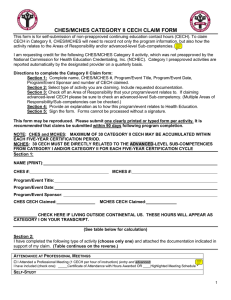Lecture 11
advertisement

Lecture 11
U open in Cn , ρ ∈ C ∞ (U ), ρ : U → R ten ρ is strictly plurisubharmonic if for all p ∈ U the matrix
�
�
∂2ρ
(p)
∂zi ∂z̄j
is positive definite.
If U, V open in Cn then ϕ : U → V is biholomorphic then for ρ ∈ C ∞ (V ) strictly plurisubharmonic ϕ∗ ρ
is also strictly plurisubharmonic. If q = ϕ(p)
� ∂ 2 ρ ∂ϕk ∂ ϕ̄l
∂2 ∗
ϕ ρ(q) =
∂zi z̄j
∂zi ∂z̄l ∂zl ∂z̄j
k,l
the RHS being s.p.s.h implies the right hand side is also.
Definition. U open in Cn is pseudo-convex if it admits a s.p.s.h exhaustion function. We discussed the
examples before (in particular if U1 , U2 pseudo-convex, U1 ∩ U2 is pseudo-convex)
The observation above gives that pseudoconvexity is invariant under biholomorphism.
Theorem (Hormander). U pseudo-convex then the Dolbeault complex on U is exact.
Back to Cech Cohomology
X a complex n-dimensional manifold and U = {Ui , i ∈ I} and F a sheaf of abelian groups. We get the Cech
complex
C 0 (U, F)
δ
� C 1 (U, F)
δ
� ...
and H p (U, F) is the cohomology group of the Cech complex. We proved earlier that H 0 (U, F) = F(X).
Also, we showed that if F is one of the sheaves that we discussed H p (U, F) = 0, p > 0 i.e. F = C ∞ , Ωr , Ωp,q .
But what we’re really interested in is F = O.
Definition. U = {Ui , i ∈ I} is a pseudoconvex cover if for each i, Ui is biholomorphic to a pseudoconvex
open set of Cn .
Theorem. If U is a pseudoconvex cover then the Cech cohomology groups H p (U, O) are identified with the
cohomology groups of the Dolbeault complex
Ω0,0 (X)
∂
� Ω0,1 (X)
∂
� Ω0,2 (X)
∂
� ...
This is pretty nice, because its a comparison of very different objects. We do a proof by diagram chasing.
The rows of this diagram are
δ
0
δ
� Ω0,q (X)
δ
� C 0 (U, Ω0,q )
� C 1 (U, Ω0,q )
δ
� ...
To figure out the columns we have to create another way looking at the Cech complex.
Let N be the nerve of U, J ∈ N p , c ∈ C p (U, Ω0,q ) iff c assigns to J an element c(J) ∈ Ω0,q (UJ ).
Define ∂c ∈ C p (U, Ω0,q+1 ) by
∂c(J) = ∂(c(J))
2
now ∂ : C p (U, Ω0,q ) → C p (U, Ω0,q+1 ) and we can show that ∂ = 0.
Its not hard to show that the diagram below commutes.
δ
C p (U, Ω0,q )
� C p+1 (U, Ω0,q )
∂
∂
�
C p (U, Ω0,q+1 )
δ
�
� C p+1 (U, Ω0,q+1 )
∂
→ C p (U, Ω0,1 ), what is the kernel of ∂. c ∈ C p (U, Ω0,0 ), J ∈ N p , c(J) ∈
Consider the map C p (U, Ω0,0 ) −
∞
C (UJ ) and ∂c(J) = 0 then c(J) ∈ O(UJ ). So we can extend the arrow that we are considering as follows
i
C p (U, O)
� C p (U, Ω0,0 )
∂
� ...
� C p (U, Ω0,1 )
Theorem. The following sequence is exact
∂
C p (U, Ω0,0 )
� C p (U, Ω0,1 ) ∂
� ...
Observation: J ∈ N p . The set UJ is biholomorphic to a pseudoconvex open set in Cn . Why? UJ is
non-empty and it is the intersection of pseudoconvex sets, and so it is also pseudoconvex.
Suppose we have c ∈ C p (U, Ω0,q ) and ∂c = 0. For J ∈ N p , c(J) ∈ C ∞ (UJ ) and ∂c(J) = 0. So there is
an fJ ∈ Ω0,q+1 such that ∂fI = c(J). Now define c′ ∈ C p (U, Ω0,q−1 ) by c′ (J) = fI . Then ∂c′ = c.
Now, for the diagram. Set C p,q = C p (U, Ω0,q ), and Aq = Ω0,q (X), B p = C p (U, O). We get the following
diagram
..
..
..
..
.�
.�
.�
.�
∂
A3
i
A2
i
A1
i
A1
i
� C 0,3
�
∂
δ
∂
� C 0,2
�
� C 1,2
�
� C 1,1
�
� C 1,0
�
δ
� C 2,2
�
� C 2,1
�
� C 2,0
�
δ
� ...
� C 3,2
�
δ
� ...
δ
� ...
δ
� ...
∂
δ
∂
δ
� C 3,3
�
∂
δ
∂
δ
∂
δ
� C 2,3
�
∂
∂
δ
∂
δ
∂
� C 0,0
�
δ
∂
δ
∂
� C 0,1
�
� C 1,3
�
∂
� C 3,1
�
∂
δ
� C 3,0
�
i
i
i
i
B0
B1
B2
B3
All rows except the bottom row are exact, all columns except the the left are exact. The bottom row computes
H p (U, O) and the left hand column computes H q (X, Dolbeault). We need to prove that the cohomology of
the bottom row is the cohomology of the left.
Hint: Take [a] ∈ H k (X, Dolbeault), a ∈ Ak = Ω0,k (X). The we just diagram chase down and to the
[b] is in fact a
right, eventually we get down to a [b] ∈ H k (U, O). We have to prove that this case [a]
mapping (we do this by showing that the chasing does not change cohomology class) and we have to show
that the map created is bijective, which is not too hard.




